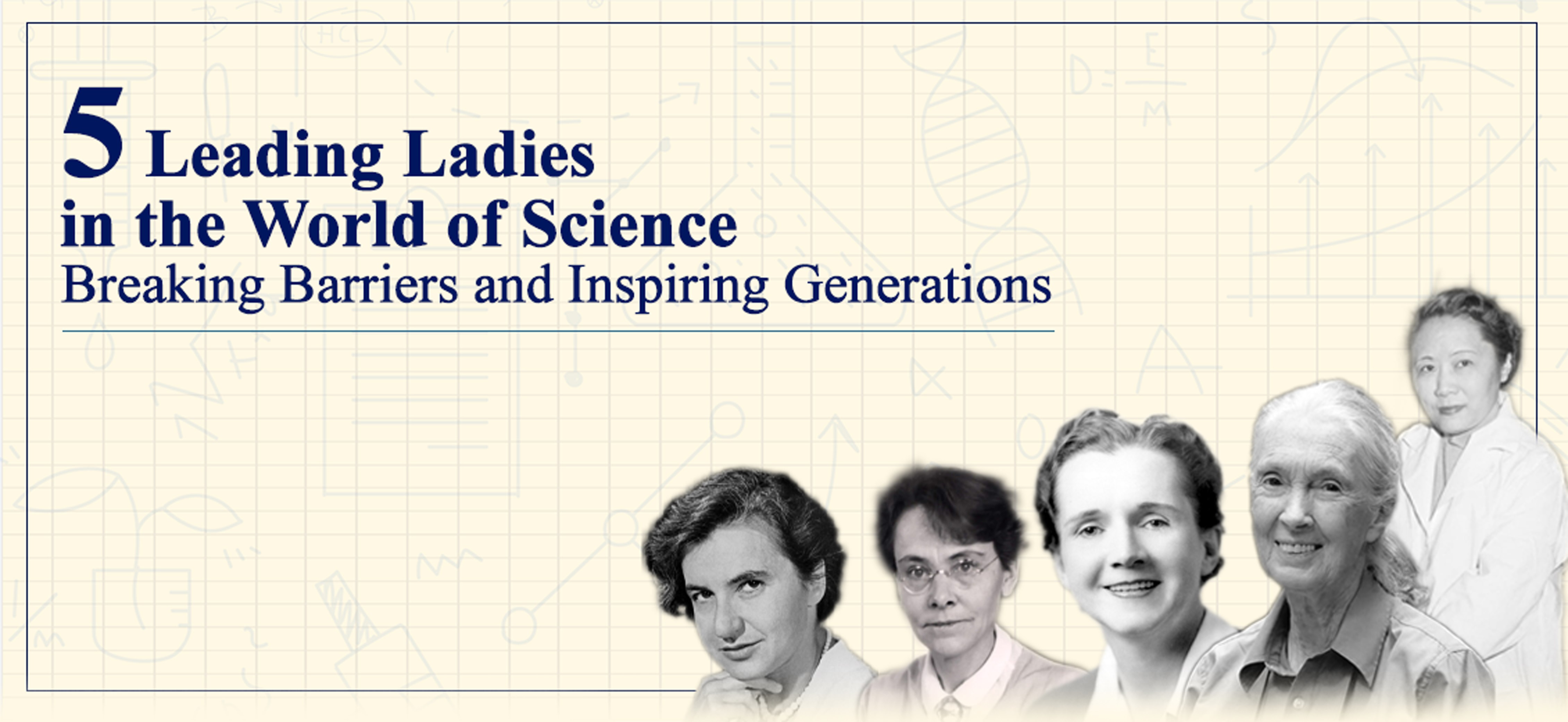5 Leading Ladies in the World of Science: Breaking Barriers and Inspiring Generations
Blogs Home
- 11 Feb 2023

Men have traditionally dominated science, but over the years, women have made significant contributions and broken barriers to become leading figures in their respective fields. In this blog post, we will be highlighting 5 women who have made a significant impact in the world of science and have inspired generations to come. From groundbreaking research to being trailblazers in their respective fields, these women have proven that gender should never be a barrier to achieving greatness.
1. Rosalind Franklin (1920-1958) - The X-ray Crystallographer who Unlocked the Secrets of DNA
Rosalind Franklin was a British chemist and X-ray crystallographer, born in London in 1920 and graduated from Cambridge University in 1941 with a degree in physical chemistry. After working at the British Coal Utilization Research Association for several years, she moved to Paris to work at the Laboratoire Central des Services Chimiques de l'Etat, where she developed her skills in X-ray crystallography.
Her work was crucial in the discovery of the double helix structure of DNA. Franklin's X-ray diffraction images, particularly Photo 51, provided crucial information that allowed James Watson and Francis Crick to determine the structure of DNA. Franklin continued to make important contributions to science. She went on to study the structure of viruses, and her work in this field helped to pave the way for the development of modern virology.
Though Franklin did not receive the recognition she deserved during her lifetime, her work has since been recognized as vital to the discovery of the structure of DNA. Her story serves as a reminder of the challenges faced by women in science and the importance of recognizing and valuing the contributions of all scientists, regardless of their gender.
2. Chien-Shiung Wu (1912-1997) - The Chinese-American Physicist who Challenged the Law of Conservation of Parity
Chien-Shiung Wu was a Chinese-American physicist who was born in Liuhe, China in 1912 and received her undergraduate degree in physics from National Central University in China in 1934.
In the post-war years, Wu continued her research in nuclear physics and made several groundbreaking discoveries. One of her most notable achievements was her experimentation on the process of beta decay, which is a type of radioactive decay that occurs when a neutron in the nucleus of an atom decays into a proton, an electron, and an antineutrino. Wu's experiments disproved the principle of conservation of parity, which stated that the laws of physics are the same for all observers regardless of their relative motion.
Wu is best known for her experiment, known as the Wu experiment, which disproved the hypothetical law of conservation of parity in subatomic physics. This groundbreaking work earned her the nickname "First Lady of Physics" and she remains an inspiration to female scientists around the world. Her work and contributions not only made a significant impact in the field of physics but also encouraged women in science to pursue their dreams and breaking barriers for them.
3. Barbara McClintock (1902-1992) - The Geneticist who Discovered Mobile Genetic Elements
Barbara McClintock was an American cytogeneticist and one of the pioneers of modern genetics. She is Born in 1902 in Hartford, Connecticut, McClintock began her scientific career at Cornell University, where she earned her PhD in botany in 1927.
One of McClintock's most significant contributions was her discovery of "jumping genes," also known as transposable elements. These are segments of DNA that can move from one location on a chromosome to another, sometimes even switching positions with other genes. McClintock first observed these elements in the early 1940s and spent the next decade studying their behavior and the effects they have on the expression of other genes. Her work helped to revolutionize our understanding of genetics and the way in which genetic information is regulated. She earned Nobel Prize in Physiology or Medicine in 1983, making her the first female scientist to win this award in her own right.
4. Rachel Carson (1907-1964) - The Biologist who Raised Awareness about the Harmful Effects of Pesticides
Rachel Carson was an American marine biologist and conservationist born in 1907 in Springdale, Pennsylvania and grew up on a farm. Her work helped to shape the modern environmental movement. She is best known for her book "Silent Spring," which raised awareness about the harmful effects of pesticides on the environment and human health. Carson's work played a crucial role in the ban of DDT and other harmful pesticides.
Rachel Carson's work on environment conservation is still relevant today. Her book Silent Spring sparked the modern environmental movement, which has since grown to encompass a wide range of issues related to conservation and sustainable development. Her legacy continues to inspire many people to take action to protect the environment, and her work has had a lasting impact on public policy and public awareness.
5. Jane Goodall (born 1934) - The Primatologist who Revolutionized the Study of Chimpanzees
Jane Goodall is a British primatologist and anthropologist who is best known for her long-term study of chimpanzees in Tanzania. Born in London in 1934, Goodall began her research in 1960 at the young age of 26, studying chimpanzees in Tanzania's Gombe Stream National Park. Her work has transformed our understanding of these animals and the way we view them, and her contributions to the field of primatology have been recognized and celebrated around the world.
In addition to her groundbreaking research, Goodall is also an advocate for conservation and animal welfare, she travels the world giving speeches and lectures, and is a passionate supporter of sustainable development and community-based conservation. She is also a vocal critic of the use of chimpanzees in medical research and entertainment, and works to raise awareness about the plight of chimpanzees in captivity. She continues to inspire generations of scientists and conservationists with her work.
In conclusion, these five women have made significant contributions to the world of science and have inspired generations to come. From groundbreaking research to being trailblazers in their respective fields, these women have proven that gender should never be a barrier to achieving greatness. We hope that their stories will inspire more young women to pursue careers in science and to break barriers in their own fields. This blog post is to serve as a reminder that representation matters and it should be celebrated, and to continue to work on making the field of science more inclusive and diverse.
Aditi Saini
After pursuing Master's in Political Science from Indraprastha College for Women, Delhi University, she engrossed herself in Content Writing. Apart from being honest and a kind person, she is a good learner with the motto of "Live and let live".
Blogs Home




